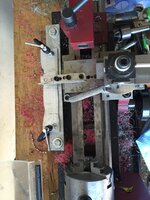@FGarbrecht
I use the same method as you, Fred, but in fewer "steps", so the profile is initially a rougher approximation to the target.
All my lathe cutting is done with the blank held between centers.
I first calculate (using a bit of easy trigonometry) the angle to get me from the "end hardware diameter" to the "target center diameter" (which may not be at the geometrical center of the blank's length -- depends on the profile I am trying to achieve). . I never actually use this angular setting; it is just a rough starting point . I start my lathe cuts by using about twice this angle for my first cross-slide/compound angle setting and gradually work my way to this "profile" at the first end of the blank being careful to not go below the "end hardware diameter" right at the end (getting to this may take several passes with the cutting tool). . I repeat the cuts (with the blank reversed) at the other end of the blank. . I then reduce the first angle by half and make another two "profile adjustments" but this time I center my cuts on the "high point" of the previous cut. . These are the only two "profile adjustments" that I do with the lathe cutting tool. . The rest of the curve profiling is done by sanding (a little initial rough filing if necessary). . I have found that the actual angular settings for the compound are not critical; I do the calcs to improve my confidence in what I am doing.
In setting the two angles for the cross-slide/compound angle (after loosening the two hold-down hex-cap screws), I use a digital protractor (...www.generaltools.com ... Model 1702). . ... because I do not trust the angle settings pre-marked on the lathe cross-feed. . Using this digital protractor is the only part of my method that differs from the essentials of your method as I understand it.
I agree that doing the angular settings is a bit of a pain, but I only do it twice per blank, so it is not too bad. . The digital protractor is a help, especially with accuracy and reproducibility of the small angle settings that are involved (I feel).
If you want any further details ... in particular related to the trigonometric calcs, just let me know.
I have never done any concave profiling, only convex.
EDIT: I must say that I admire Danny's patience to make a "pattern tracer jig" for each profile that he wants, and working out how to mount and clamp all the pieces that are involved. . I will now work my way through his description of his method which I'm quite sure is superior to mine.

